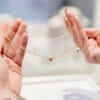Urinary Incontinence & Use of Herbal Supplements for Overactive Bladder
Urinary incontinence is defined as the involuntary release of urine in the bladder. The normal flow of urine from the bladder is controlled with multiple body systems and valves known as sphincters that open and close to start and stop the flow.
When someone is suffering from urinary incontinence, these processes no longer work the way they should and urine can flow out through normal daily activities like laughing, coughing, or bodily activity.
Understandably, the challenges associated with these symptoms may have a critical effect on somebody’s wellbeing.So what contributes to these bladder health difficulties and who is at greatest risk to suffer from them?
Let’s explore.
Symptoms, Causes & Risk Factors
When you feel as if you have lost control of your bladder to the point that it’s so frequent that it adversely affects your quality of life, so it’s probably time to see a physician.
Age and sex have a big part to play in discovering urinary incontinence hazards.
Urinary incontinence in women is much more prevalent than it is in males, and the probability of urinary incontinence increases with age (particularly beyond 70 years old).
Other risk factors for urinary incontinence include:
- Smoking
- Family history
- Menopause
- Pregnancy, child birth
- Other health conditions (diabetes, neurological conditions, prostate conditions)
- Urinary tract infection
- Constipation
- Weak pelvic muscles
- Excess caffeine/alcohol consumption
There are a number of different types of urinary incontinence, each brought about by different causes.
Three of the most common types include:
- Stress Incontinence – Despite what it sounds like, stress incontinence does not actually have to do emotional stress. Rather, it means that the muscles of your pelvis (including your sphincters, discussed in the previous section) may be weakened or damaged and may leak urine as a result of the strain from coughing or physical activity.
- Urge Incontinence – Sometimes referred to as an “overactive bladder”, this type of urinary incontinence arises when you consistently feel the need to use the washroom even your bladder is essentially empty. It can occur in both men and women, especially postmenopausal women and men who have prostate issues.
- Overflow Incontinence – This type of urinary incontinence is more common in men with prostate issues and occurs because of a blockage in the bladder (often caused by an enlarged prostate) which means it does not empty properly and eventually leads to urine leaking out because it remains too full.
So what can be done about it?
The Treatment of Urinary Incontinence
Depending on the type of urinary incontinence, there are a number of treatment and management strategies available to you both in terms of lifestyle changes and medical intervention.
Since the medical aspect (pharmaceuticals, surgery) of urinary incontinence treatment is best left with your healthcare team, I will instead focus on some of the lifestyle and dietary changes you can make to reduce your risk.
#1 Kegel or Pelvic Floor Exercises:
Women, in particular, may have weakened pelvic muscles as a result of pregnancy and childbirth. Over time, these weakened muscles may increase their risk for urinary incontinence and is a big reason why women are more likely to suffer from it in the first place. Pelvic floor exercises, also known as Kegels, can be an effective way to strengthen these muscles and reduce the risk of urinary incontinence in some people.
Kegel exercises can also help support a process known as bladder retraining, which can be a very effective. It involves tracking your urination habits and increasing the interval between washroom visits.
#2 Manage Your Fluid Intake:
Your healthcare term may recommend slightly reducing your fluid intake to see if it improves symptoms. Certain types of beverages, especially caffeine and alcohol may increase the risk of incontinence in some, but not all.
#3 Improve Diet/Weight Loss:
A recent Cochrane review determined that weight loss may be a promising intervention for reducing risk of urinary incontinence. Given that constipation and low vitamin D levels may also be a risk factor, it does appear that general dietary improvement may be a promising supplemental management approach.
#4 Top Bladder Control Supplements:
Supplementation in the treatment of urinary incontinence is a very popular topic because the medications that are commonly prescribed for the condition tend to come with unpleasant or at the very least undesirable side effects.
As a result, it’s not unusual for people to be drawn in by the idea of a bladder health supplement, bladder control supplement, or just general bladder supplement of any kind that could offer support or relief.
But is there any evidence that these types of products work?
The list includes:
-
-
- Gosha-jinki-ga
- Hachi-mi-jio-gan
- Buchu
- Cornsilk
- Cleavers
- Horsetail
-
Although I appreciate the desire to explore herbal remedies, more definitive research will be required on the safety and effectiveness of these supplements before they can be recommended for widespread use in the management of urinary incontinence.
-
-
- Capsaicin, which is sourced from chile peppers and often used in topical pain relief ointments has also generated some interest as a potential tool to relieve pelvic pain in those living with these issues.
- Pumpkin seed oil has also been explored as a potential alternative strategy. There is evidence to suggest that individuals who supplemented with pumpkin seed oil over an extended period of time enjoyed a reduction in overactive bladder symptoms. Pumpkin seed oil is widely available online and may represent a low-risk treatment alternative that will almost certainly be a topic of future research.
- Magnesium Hydroxide is another bladder control supplement that has garnered some interest in the research community. Magnesium may play a modest role in relaxing muscles and leading to less spontaneous contractions of the pelvic muscles, thus reducing the number of urgent bathroom visits.
- Pollen extract has been identified as a potential treatment alternative for incontinence and is currently being studied for its effectiveness.
- L-Arginine has been studied and shows some promise specifically in the management of a condition known as Interstitial Cystitis which may also increase urinary frequency and urgency.
-
For all of the above, higher-quality research will be required before definitive claims can be made about their effectiveness in incontinence management – speak with your healthcare provider before using l supplements of any kind.
There are a number of comprehensive reviews on the management of urinary incontinence that does not even mention supplementation because, despite some interesting research in this area, there is a lack of compelling high-quality evidence that such products truly help – especially as compared to the other management methods discussed above.
If you choose to use a bladder health supplement of any kind, be sure to speak with your healthcare team to ensure it’s safe and does not interact with your medications or current health condition.
#5 Alternative Therapies:
Less conventional treatment modalities such as acupuncture have been suggested as a potential symptom reduction strategy in urinary incontinence treatment, but more evidence is required before decisive claims can be made.
Conclusion
Urinary incontinence and urinary incontinence treatment may seem like massive and overwhelming topics, and they kind of are.
There are a number of different reasons why urinary incontinence can occur in any given individual, but the biggest thing holding you back from managing these symptoms is most likely to be your willingness to share the necessary details with your healthcare provider.
If you find yourself in a position where urinary incontinence is greatly impacting your quality of life, or you suspect it might be, speak with your doctor.
As I began to introduce to you in today’s article, there a wide range of treatment options available to you if lifestyle modifications aren’t sufficient.
The post Everything You Need To Know About Urinary Incontinence & Use of Herbal Supplements for Overactive Bladder appeared first on.
Read Also: How Long Does it Take to Get Into Ketosis?

















